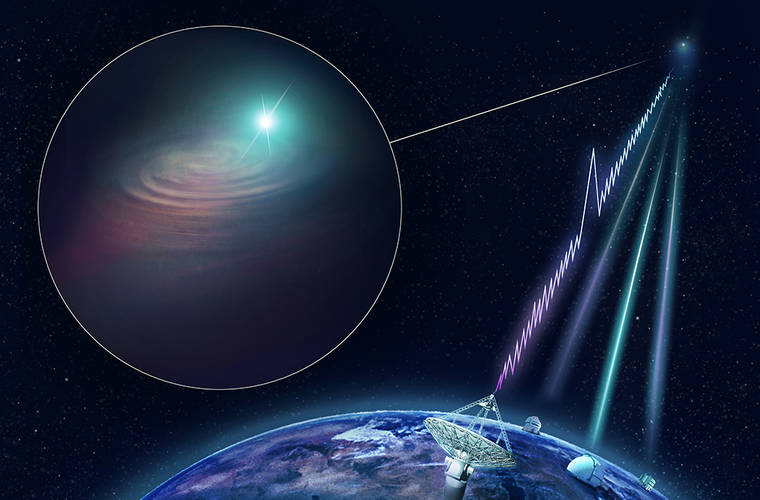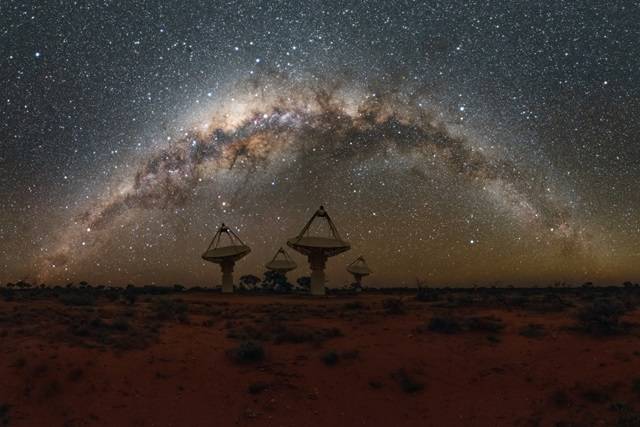HILO — Astronomers are now able to pinpoint the origin of cosmic radio waves over billions of light years thanks in part to W. M. Keck Observatory on Maunakea.
An international team of astronomers, led by Australia’s Commonwealth Scientific and Industrial Research Organization, used a radio telescope array and three of the world’s most powerful optical telescopes to find and image the source of a powerful burst of radio waves from a distant galaxy.
The radio waves came in the form of a fast radio burst, a pulse of radio waves lasting for, at most, mere milliseconds.
“One of the key issues with fast radio bursts is that most of them burst exactly once,” said John O’Meara, chief scientist at Keck Observatory and co-author of CSIRO’s research paper on the discovery.
Thanks to an observatory in Western Australia, however, a burst detected on Sept. 24 last year was traced back to a galaxy located about 3.6 billion light years away.
The observatory that detected the burst was the Australian Square Kilometre Array Pathfinder, an array of 36 antennas working in tandem across about 4,000 square meters. Because the antennas are spread apart, O’Meara said, they actually detected the burst at very slightly different times — “a fraction of a billionth of a second,” according to co-author Adam Deller of Swinburne Institute of Technology.
By analyzing data from the array, O’Meara said astronomers were able to use those infinitesimal differences in detection times to triangulate the galaxy at the source of the burst, using the 10-meter Keck II telescope on Maunakea to determine its distance from earth.
Telescopes at W. M. Keck Observatory on Maunakea, Gemini South in Chile and the European Southern Observatory’s Very Large Telescope, also in Chile, helped image the source galaxy — which is designated DES J214425.25-405400.81.
This is not the first fast radio burst to be traced back to its source; the origin of one other burst was found in 2017. However, that burst was a “repeater,” a recurring radio burst that repeatedly emanates from the same spot. The 2018 burst was a “one-off” that does not appear to repeat, O’Meara said.
O’Meara said astronomers can now analyze the source galaxy to determine what about it could have generated the burst. For example, he said, if the galaxy is young, then the cause of the burst might be inferred to be related to star-forming processes associated with younger galaxies. Conversely, if the galaxy is older, as it appears to be in this case, then different processes might be responsible for the burst.
While nearly 100 fast radio bursts have been detected since they were discovered in 2007, their sources are a matter of discussion. Many of the leading theories involve neutron stars because of their powerful magnetic fields, O’Meara said: collapsing neutron stars, matter falling into a neutron star or multiple neutron stars colliding with each other are all possible sources. Another theory involves black holes interacting with the surrounding universe, but no theory has yet been conclusively proven.
O’Meara said fast radio bursts are likely far more frequent than we have been able to detect, but they are difficult to detect due to their short interval and the limited amount of space any telescope can observe. He compared them to a similar phenomenon called gamma ray bursts: previously very difficult to detect because of their brief lifespans, but discovered to be more abundant after astronomers knew what to look for.
Discovering the source of fast radio bursts, therefore, will help discover more of them, O’Meara said, which will not only help us learn more about other galaxies, but also about the space between them. If astronomers know the distance between the burst’s source and Earth, they can also determine how the burst is diffused within the intervening space and, through this, determine the number of atoms between the Earth and the source galaxy.
“Independently, these data offer an entirely new method to measure the amount of matter in the cosmos,” said J. Xavier Prochaska of the University of California, Santa Cruz.
Email Michael Brestovansky at mbrestovansky@hawaiitribune-herald.com.






